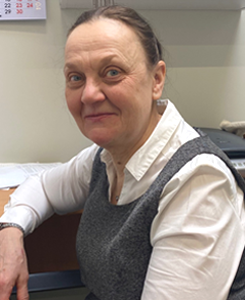 |
Maria S. Yurkova Ph.D. (Biology) Head of Laboratory INBI, build. 5 |
Keywords
Proteins, protein engineering, protein stabilization, molecular chaperones, GroEL, preclinical trials, toxicology, producer strains.
Area of research
The basic goal of our research is development of new systems for producing and stabilization of proteins and methods of their affinity purification. We use molecular chaperones as a framework for making fusion systems to improve characteristics of target protein and efficiently produce hard-to-express target polypeptides.
1. Bioengineering of molecular chaperone systems for protein biotechnology
- A highly efficient system for biosynthesis of toxic or labile peptides inside the chaperonin GroEL complex is developed
To prove the efficiency of this system, in bacterial cells were produced polyphemusin, one of the most potent antibacterial peptides, and enfuvirtide, at present the longest therapeutic peptide used in treatment of AIDS patients - A system for production of initially insoluble proteins in stable soluble forms as fusions with minichaperone is developed
In this system, two initially insoluble proteins, E6 of human papilloma virus and N-terminal fragment of hepatitis C E2, were produced in stable soluble form. Both these proteins are considered as candidates for development of corresponding vaccines. The capability of this system has been extended by creation of minichaperone’s permutated variants.
2. Development of new methods of protein folding and purification
Folding of hydrophobic proteins on solid matrix
3. Research of recombinant protein therapeutic drugs and vaccines
Research of new vaccines for rubella, human papillomavirus
4. Development of recombinant enzyme producing strains and enzyme purification technologies for industrial applications
Producing strains of enzymes used in the food industry, phospholipase A2 and chymosin, have been developed. The characteristics of the producing strains as well as the methods of enzyme purification meet the requirements and standards adopted in the food industry.
5. Analysis of the metabolome and systems regulating the expression of recombinant proteins in microorganisms
6. Development of vaccines for the prevention of human and agricultural animal diseases
Vaccines for swine circovirus, African swine fever
7. Bioinformatic analysis of the fine structure of genomes
Analysis of principles and global systems of regulation of protein expression
Main research methods:
- Genetic engineering
- Directed mutagenesis
- Development of protein producing strains
- Chromatographic methods of protein purification
- Analysis of proteins, proteomes and metabolomes by LC-MS methods
- Electrophoretic analysis of proteins under denaturing and native conditions
Selected publications:
- Alexey N. Fedorov. Biosynthetic Protein Folding and Molecular Chaperons REVIEW Biochemistry (Moscow), 2022, Vol. 87, Suppl. 1, pp. S128_S145. DOI: 10.1134/S0006297922140115;
- Yurkova, M.S., Sadykhov, E.G. & Fedorov, A.N. Production of a toxic polypeptide as a fusion inside GroEL cavity. Sci Rep10, 21024 (2020). https://doi.org/10.1038/s41598-020-78094-8;
- Filkin S.Y, Chertova N.V, Zenin A.A, Lipkin A.V, Sichev A.A, Bityak D.S, Sadykhov E.G, Popov V.O, Fedorov A.N. Expression, purification and biophysical characterization of recombinant Streptomyces violaceoruber phospholipase PLA2 overproduced in Pichia pastoris. Prep Biochem Biotechnol. 2020;50(6):549-555. doi: 10.1080/10826068.2020.1712657;
- Filkin S.Y, Chertova N.V, Vavilova E.A., Zatsepin S. S, Eldarov M. A., Sadykhov E.G, Fedorov A.N., Lipkin A.V.Optimization of the Production Method for Recombinant Chymosinin the Methylotrophic Yeast Komagataella phaffii . Applied Biochemistry and Microbiology, 2020, Vol. 56, No. 6, pp. 657–661. doi: 10.1134/S0003683820060058;
- Maria S. Yurkova, Olga A. Sharapova, Vladimir A. Zenin, and Alexey N. Fedorov. Versatile format of minichaperone-based protein fusion system. Scientific Reports, v 9, issue 1, pp. 1-11. doi: 10.1038/s41598-019-51015-010;
- Fedorov A.N., Yurkova M.S.. Molecular Chaperone GroEL – toward a Nano Toolkit in Protein Engineering, Production and Pharmacy. NanoWorld J 2018, 4(1): 8-15. doi: 10.17756/nwj.2018-053;
- Trifonova E.A., Zenin V.A., Nikitin N.A., Yurkova M.S., Ryabchevskaya E.M., Putlyaev E.V., Donchenko E.K., Kondakova O.A., Fedorov A.N., Atabekov J.G., Karpova O.V. Study of rubella candidate vaccine based on a structurally modified plant virus .Antiviral Research 2017, 144, 27-33;
- Sharapova O.A., Yurkova M.S., and Fedorov A.N. A minichaperone-based fusion system for producing insoluble proteins in soluble stable forms. Protein Engineering, Design and Selection, 2016, Volume 29, Issue 2, Pages 57–64, https://doi.org/10.1093/protein/gzv060;
- Sharapova O.A., Laurinavichyute D.K., Yurkova M.S., Andronova S.M., Fedorov A.N., Severin S.E., Severin E.S. Efficient refolding of a hydrophobic protein with multiple S-S bonds by on-resin immobilized metal affinity chromatography. Journal of Chromatography, 2011, 1218 (31): 5115-9;
- Fedorov A., Baldwin T. Process of biosynthetic protein folding determines the rapid formation of native structure. — J. Mol. Biol., 1999, v. 268, p. 712-723;
- Fedorov A., Baldwin T. Protein folding and assembly in a cell-free expression system. — Methods in Enzymology, 1998, v. 290, p. 1-17;
- Fedorov A., Baldwin T. Cotranslational protein folding. — J. Biol. Chem., 1997, v. 272, p. 32715-32718;
- Fedorov A., Baldwin T. Contribution of cotranslational folding to the rate of formation of native protein structure. — Proc. Natl. Acad. Sci. USA, 1995, v. 92, p. 1227-1231;
- Fedorov, A., Dolgikh, D., Chemeris, V., Chernov, B., Finkelshtein, A., Schulga, A., Alakhov, Yu., Kirpichnikov, M. & Ptitsyn, O. De novo design, synthesis and study of albebetin, a polypeptide with a predetermined three-dimensional structure. Probing the structure at the nanogram level. — J. Mol. Biol., 1992, v. 225, p. 927-931.